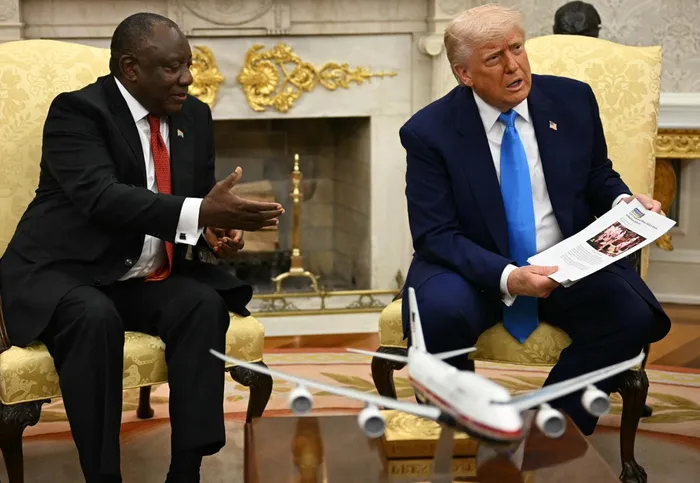Ramaphosa’s missed moment to reposition South Africa as Africa’s strategic business hub
Opinion

President Cyril Ramaphosa entered the Oval Office with a chance to reshape South Africa's image as a significant gateway to Africa. However, he departed with the narrative largely influenced by Donald Trump, and the headlines were dominated by unverified claims of a "white genocide," says the writer.
Image: Jim Watson/ AFP
When diplomacy meets drama, perception often becomes policy. On May 21, 2025, South African President Cyril Ramaphosa entered the Oval Office with an opportunity to reshape South Africa’s image as a global gateway to Africa.
Instead, he left with the narrative dictated by Donald Trump and headlines dominated by unproven claims of a ''white genocide''. What should have been a calculated moment of soft power deployment turned into a textbook case of diplomatic inertia in the face of performative politics.
In what many expected to be a reconciliatory meeting aimed at re-establishing commercial and geopolitical ties, Ramaphosa was confronted with inflammatory visuals and commentary from President Trump.
The US president, known for his theatrical tactics and populist posturing, dimmed the lights and presented a video montage of anti-white chants and cross-covered memorials, alleging state-sanctioned violence against white farmers. The spectacle was designed not to illuminate, but to provoke — and it worked. But what followed was even more concerning: silence.
A Stage Missed, A Nation Muffled
While Trump was playing to his base with his usual flair for controversy, Ramaphosa missed a statesman’s moment: the chance to reframe the narrative firmly, factually, and boldly. This was not merely about setting the record straight on rural crime statistics or land reform. This was about telling the world what South Africa is today — and more importantly, what it aspires to be.
South Africa is not collapsing under racial violence. It is, in fact, home to over 600 American companies thriving across diverse sectors — from finance and energy to manufacturing and ICT. It hosts the continent’s most sophisticated financial markets and a judiciary that, though imperfect, remains independent and respected. Yet none of this was articulated when the world's cameras were rolling.
PR, Perception, and the Politics of Absence
In global affairs, perception shapes capital. Investors are not just moved by credit ratings or fiscal reports; they are swayed by the tone of a president's voice, the clarity of a message, and the confidence of a country in telling its own story. South Africa has a compelling one — but its narrator hesitated.
Ramaphosa’s failure was not moral. It was strategic. In an era where misinformation can become policy and sensationalism can outpace substance, silence is not neutrality — it is concession. By not vigorously defending the country’s democratic progress, racial cohesion efforts, and economic potential, Ramaphosa allowed South Africa’s image to be reframed not as a land of opportunity but as a crisis state.
This is not about debating the existence of crime in rural South Africa—that conversation belongs to police reports, not foreign policy. What was required was presidential framing: to acknowledge challenges while emphasising opportunity; to redirect the discussion toward trade, investment, and innovation.
Selling the South African Story—What Could Have Been Said
A more assertive South African president might have turned the meeting on its head with a message like this:
“Mr. President, over 600 U.S. companies have chosen South Africa as their African headquarters. They are growing, hiring, and exporting. While we face the reality of inequality and crime, just as every society does, our constitutional democracy, rule of law, and economic fundamentals remain strong. South Africa is not a place to fear. It is a place to invest.”
That is what global investors, diaspora communities, and diplomatic allies needed to hear. Not a defensive rebuttal. A confident invitation.
The African Gateway That Was Not Mentioned
In a world shifting toward multi-polarity and regional trade blocs, South Africa’s location, infrastructure, and institutions uniquely position it as the natural entry point into Africa's $3.4 trillion Continental Free Trade Area (AfCFTA). With over 60 million people, a young, growing population, and access to regional markets, the country remains an unmatched launchpad for U.S. and global companies seeking footholds in the Global South.
Yet, these economic imperatives were buried beneath a conversation hijacked by a fringe narrative. Ramaphosa had the chance to steer the world toward understanding South Africa as not just a political experiment, but a business solution, and failed to do so.
The Geopolitical Cost of Narrative Surrender
The diplomatic cost of this missed opportunity goes beyond bilateral ties with the U.S. South Africa, as a G20 member, a BRICS+ participant, and Africa’s most industrialised economy, has global symbolic weight. When its president fails to define its vision on the world’s most watched political stage, it sends a signal of hesitancy and retreat. In contrast, nations like India, Kenya, and even Rwanda have mastered the art of global storytelling, pitching themselves as open for business while navigating internal challenges.
Conclusion: A Lesson in Strategic Storytelling
In the end, diplomacy is performance. It is a narrative. It is the skilful merging of truth and persuasion. On May 21, 2025, South Africa had the spotlight, the credentials, and the moral high ground. What it lacked was the voice.
President Ramaphosa may have sought diplomacy through restraint, but in a media-fuelled, hyper-visual global environment, the absence of a clear, confident story is not interpreted as humility—it is seen as weakness.
The Oval Office became a missed megaphone. Next time, South Africa must speak like a nation that understands its worth.
Anda Mbikwana is a PhD candidate and a municipal finance and leadership in governance expert. He writes in his personal capacity.
Related Topics: